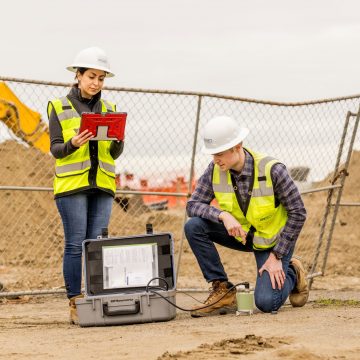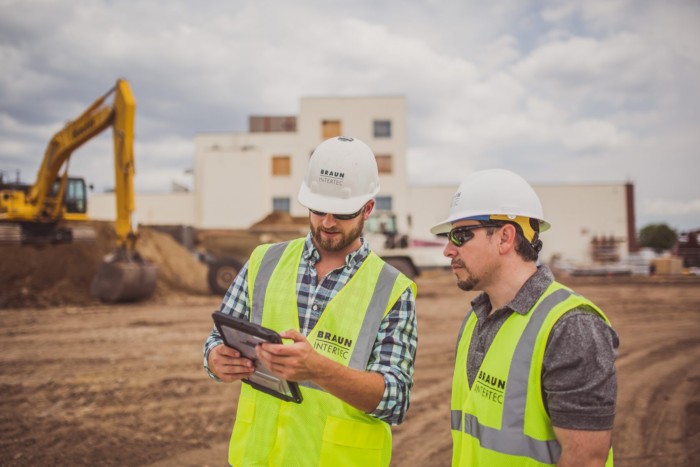Exactly How a Skilled Tailings Engineer Can Enhance Your Mining Procedures
Exactly How a Skilled Tailings Engineer Can Enhance Your Mining Procedures
Blog Article
Understanding the Crucial Function of the Geotechnical Sector in Modern Building Projects and Framework Advancement
The geotechnical industry is a foundation of modern building and construction and infrastructure growth, supplying vital insights right into dirt habits that directly affect job end results. Through sophisticated dirt evaluations and cutting-edge design options, geotechnical professionals not just make certain architectural stability yet also address sustainability problems amid advancing environmental criteria. As facilities demands expand and new obstacles emerge, the value of this area becomes progressively noticeable. What implications might these growths have for future jobs and the total safety of our developed setting?
Importance of Dirt Evaluation
Dirt evaluation plays a critical duty in the geotechnical industry, functioning as the structure for informed decision-making in construction tasks. Precise dirt assessment is vital for identifying the viability of a site for various types of frameworks, including property homes, business structures, and bridges. By analyzing dirt structure, thickness, stamina, and wetness web content, designers can anticipate potential obstacles and reduce dangers connected with ground instability, erosion, and settlement.
The assessment procedure commonly entails a series of tests and observations that provide crucial info regarding the subsurface conditions. This information informs the design and building and construction processes, making sure that structures are developed on strong ground with appropriate support. Comprehending the dirt account allows engineers to pick proper building approaches and products, maximizing resource utilization and decreasing expenses.
In addition to making sure architectural honesty, dirt assessment adds to ecological sustainability. By recognizing prospective contamination or adverse results on bordering environments, engineers can apply methods to secure these natural resources. Generally, detailed dirt assessment is indispensable in the geotechnical area, underpinning the safety, efficiency, and ecological obligation of construction tasks.
Secret Geotechnical Strategies
A variety of vital geotechnical methods are used to evaluate and enhance the stability and efficiency of building and construction sites. One fundamental approach is soil tasting and testing, which allows engineers to identify the chemical and physical residential properties of the ground. This info is vital for making educated decisions pertaining to structure style and building approaches.
One more necessary strategy is website characterization, which entails the thorough assessment of dirt and rock conditions through approaches such as borehole drilling and in-situ testing. Methods like Criterion Penetration Tests (SPT) and Cone Infiltration Tests (CPT) give beneficial information on soil stamina and stratigraphy.
Ground improvement techniques, such as soil stablizing and grouting, are additionally vital in improving the load-bearing ability of weak soils. These techniques can alleviate settlement and improve total site problems.
In addition, slope security analysis is critical for identifying possible landslide threats and guaranteeing the safety of excavations. This analysis commonly uses numerical modeling and restriction equilibrium approaches to predict soil actions under various problems.
Including these geotechnical methods right into building planning not only maximizes job outcomes yet also guarantees the long-lasting sustainability of framework advancement.
Effect On Building And Construction Safety

Moreover, reliable geotechnical engineering involves carrying out mitigation methods for determined threats. This may consist of dirt stablizing methods, keeping structures, or water drainage systems to relieve hydrostatic stress. By attending to these variables, building and construction groups can lower the chance of crashes and improve worker safety.
Additionally, continuous surveillance of site problems is essential during construction. Geotechnical instruments can supply real-time information pertaining to ground activity and security, enabling for timely treatments when needed.
Fundamentally, the geotechnical market plays a crucial function in protecting construction tasks. By focusing on ground stability and utilizing extensive analysis approaches, the geotechnical sector not just shields the labor force however also adds to the durability and reliability of constructed facilities.
Sustainability in Geotechnical Practices

In addition, geotechnical designers are currently employing sophisticated innovations, such as geosynthetics, which boost soil security while minimizing the volume of product needed. This not just preserves resources but also leads to less waste generation (geotechnical engineers). The integration of lasting style principles right into geotechnical engineering encourages using renewable power resources in construction procedures, further minimizing carbon exhausts
Furthermore, complete site evaluations are necessary for identifying possible environmental impacts prior to construction starts. By performing these analyses, geotechnical specialists can create techniques that mitigate unfavorable impacts, making certain conformity with ecological guidelines. In general, the emphasis on sustainability within geotechnical techniques not only adds to the long life and resilience of facilities however likewise promotes check my site an accountable technique to land and source management. This dedication is essential for promoting sustainable development in the modern building and construction landscape.
Future Trends in Geotechnical Engineering
Advancement is driving the future of geotechnical design, as emerging technologies and methodologies improve the sector. The combination of sophisticated data analytics and expert system is established to transform site examination and danger analysis, enabling designers to make more enlightened decisions based on real-time data. The usage of geosynthetic products is acquiring grip, supplying lasting services that improve dirt stability and minimize ecological effect - engineer of record.
An additional significant pattern is the adoption of automated and robot systems for monitoring and building and construction procedures. These technologies not just boost precision but additionally enhance security by decreasing human involvement in hazardous settings. In addition, the execution of Structure Info Modeling (BIM) in geotechnical style assists in boosted cooperation among stakeholders, enhancing task distribution and reducing expenses.
As climate adjustment poses new challenges, the More Bonuses market is significantly concentrating on strength and adaptability in layout methods, making sure infrastructure can endure severe weather condition occasions. The recurring trend towards sustainability will drive innovation in green materials and approaches, lining up geotechnical engineering with more comprehensive environmental goals. Collectively, these trends will form an extra effective, lasting, and resistant geotechnical landscape for future tasks.
Final Thought

The geotechnical sector is a foundation of modern-day building and infrastructure growth, providing important insights into dirt habits that straight affect project end results. consulting engineer.Dirt analysis plays an essential role in advice the geotechnical industry, offering as the structure for notified decision-making in building projects. On the whole, extensive dirt evaluation is indispensable in the geotechnical field, underpinning the safety and security, effectiveness, and ecological duty of building and construction jobs
Construction safety and security is dramatically affected by geotechnical practices, as the security and honesty of the ground straight influence the general safety and security of a building and construction site.In final thought, the geotechnical market is important in modern construction and framework advancement, giving important analyses that guarantee structural stability and safety and security.
Report this page